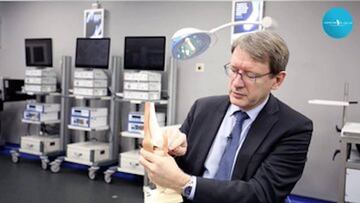Meniscus tear: Aspetar raises awareness about common sports injury
In a video posted on social media, the Aspetar sports clinic has spoken to a knee and cartilage surgery consultant about how the injury is treated and can be avoided.

One of the most common knee injuries suffered by athletes across the world is the meniscus tear, brought about by a sudden, forceful movement that puts excessive pressure on the joint during sporting activity.
Due to the regular occurrence of the injury, the sports medicine hospital Aspetar, a facility which is a part of Aspire Zone, has posted a video on Twitter that seeks to raise awareness about it, speaking to Professor Romain Seil, a knee and cartilage surgery consultant, about how the tear is treated and can be avoided.
'Traumatic' tears: the athlete's meniscus injury
“We have two menisci in the knee,” Seil says. "The meniscus is like a shock absorber between the femur [thigh bone] and the tibia [shin bone]. It's just like in your car, when you have a shock absorber to diminish the impact."
While meniscus issues can also be 'congenital' (caused by abnormal knee growth) or 'degenerative' (a result of gradual wear and tear), he explains, the type of damage that commonly occurs among athletes such as football and handball players is known as 'traumatic'.
Meniscal tears are a common sports injury, frequently occur alongside other knee injuries!
— Aspetar سبيتار (@Aspetar) June 23, 2020
What is a meniscus & how does it tear❓
What are the treatment options❓
With Prof. Romain Seil, Knee & Cartilage Surgery Consultant @RomainSeil
📽️Full Video here👉 https://t.co/K3HFWFQ1qz pic.twitter.com/SK5B1QBQQg
“These traumatic tears are caused by a sudden onset,” Seil says. “If you suffer a knee sprain, for instance, you can have an isolated meniscus lesion, or the meniscus lesion occurs in association with a ligament injury like an anterior cruciate ligament injury. We have meniscus lesions in three ACL injuries out of four.”
How is a meniscus tear treated?
Related stories
After a traumatic tear, athletes tend to need surgery to repair the meniscus, says Seil. “Previously, the meniscus was taken out, but they developed osteoarthritis very fast, because this shock absorber was not there anymore […]. It’s something which nowadays we can do much better: the techniques for meniscus repair have massively evolved over the last 10 to 20 years, and that’s why we tend to repair the menisci rather than taking them away.”
How can a meniscus tear be prevented?
Asked how the injury can be avoided, Seil said: “If you look at young athletes for example, there it’s the same as for the prevention of anterior cruciate ligament injuries - we need to prevent knee sprains. That’s the most important thing, I would say."